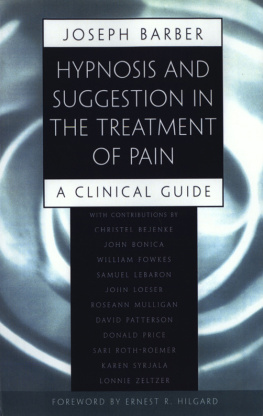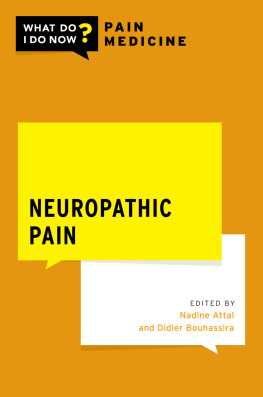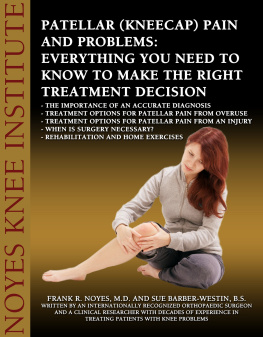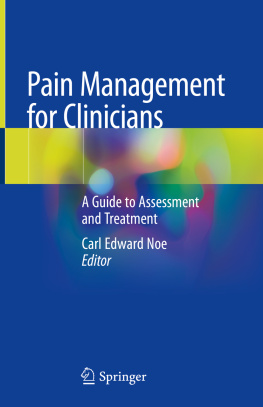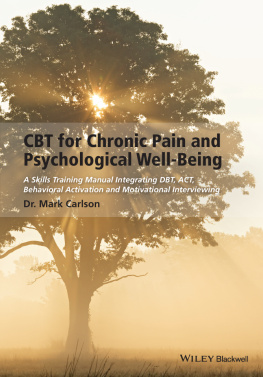HYPNOSIS
AND SUGGESTION
IN THE
TREATMENT OF PAIN

A Clinical Guide
HYPNOSIS
AND SUGGESTION
IN THE
TREATMENT OF PAIN

A Clinical Guide
A NORTON PROFESSIONAL BOOK

Copyright 1996 by Joseph Barber
All rights reserved
First Edition
For information about permission to reproduce selections from this book, write to
Permissions, W.W. Norton Company, Inc., 500 Fifth Avenue, New York, NY 10110
The Library of Congress has cataloged the printed edition as follows:
Hypnosis and suggestion in the treatment of pain: a clinical guide / [edited by] Joseph Barber ; with contributions by Christel J. Bejenke [et al.]; foreword by Ernest R. Hilgard.
p. cm.
A Norton professional book.
Includes bibliographical references and indexes.
ISBN 978-0-393-70216-3 (pbk.)
1. HypnotismTherapeutic use. 2. Mental suggestionTherapeutic use. 3. Analgesia. I. Barber, Joseph, 1948 . II. Bejenke, Christel. J.
[DNLM: 1. Pain-therapy. 2. Hypnosis. WL 704 H998 1996]
RB127.H97 1996
616.0472dc20
DNLM/DLC
for Library of Congress 96-6382 CIP
ISBN 978-0-393-70601-7 (e-book)
W.W. Norton & Company, Inc.
500 Fifth Avenue, New York, NY 10110
www.wwnorton.com
W.W. Norton & Company Ltd.
Castle House, 75/76 Wells Street, London W1T 3QT
Preface
Names and other identifying features have been altered to disguise the identities of patients whose cases are discussed in this book.
Notice, also, however, that use of these methods does not preclude use of medications. Frequently, a combination of the two provides a satisfying intervention to a complex problem.
Chapter 1
See page 10 for a definition and discussion of the components of pain experience.
The visual analogue scale is a simple, reliable measure of a variety of psychological experiences, including the experience of pain. The VAS is a horizontal line (usually 10 cm long), drawn on a sheet of paper, anchored at each end by a defining word or phrase. For instance, to measure the intensity of pain, the two ends of the VAS are defined, respectively as not intense at all and as intense as I can imagine. Instead of a horizontal line, a slide algometer (Price, Long, & Harkins, 1992b) may also be used.
A more thorough discussion of this issue is taken up in Chapter 4.
For a fuller discussion of this theoretical issue, see Barber, 1991. See also Diamond, 1984, and Gfeller, Lynn, and Pribble, 1987, for a discussion of the relationship as a determiner of the hypnotic process.
Note the case of Francisco, in Chapter 5.
Remember that, because responsivity scales offer only probabilistic information, no scale can accurately predict a particular persons responsiveness to hypnotic suggestion.
To the extent that we harbor misconceptions about hypnotic processes, we may contribute to this concern by behaving in clumsy, insensitive, or incompetent ways.
If the patient is experiencing pain during the induction, of course, this induction is not appropriate, and should be replaced by one that incorporates the experience of pain. Such an induction is described in Chapter 5.
The following is an example taken from a case of trigeminal neuralgia, a condition producing excruciating neuropathic pain.
Chapter 2
A pain specialist is a clinician specially trained in methods of the evaluation and treatment of pain.
Causalgia is a syndrome of sustained burning pain following traumatic injury.
Chapter 5
It is important to re-visit the patients pain rating throughout treatment, as a means of evaluating treatment progress.
Many piano students, for example, devote at least an hour a day to practicing. Surely, learning the effective use of self-hypnotic methods requires a similar dedication of time and intellectual focus (Holroyd. 1996).
The details of this suggestion are not pertinent here; the interested reader can learn about such posthypnotic suggestions from hypnosis texts or from clinical training programs.
I know of no evidence that hypnotic methods can affect the immune response, so 1 would not be willing to promote this possibility to a patient. However, 1 do not know what is actually possible, so, while not encouraging RaFnars hope about this, I did not discourage it.
Ragnar finally sought consultation with another oncologist, which led to a more appropriate use of opioids.
Thehe circumstances of this case also seem to disconfirm the social psychological hypothesis for hypnotic analgesia, which asserts that the individual merely behaves as if there were no pain or suffering, even while feeling pain or suffering.
Chapter 7
The following suggestions for an active and independent voice are made to facilitate the patients speaking while experiencing the relaxation and dissociation of the hypnotic state. I find these suggestions helpful for preventing the inadvertent ending of the hypnotic experience by a patients attempt to speak without quite knowing how.
Lacrimation refers to tearing from the eye; rhinorrhea to running of the nose; rhinitis to inflammation of the epithelial mucosa that lines the nasal passages.
His neurologist and I had previously agreed that she would not mention hypnosis when referring pain patients to me, since, in my view, this would create unhelpful expectations. She tended, instead, to tell patients that I was a psychologist with a great deal of experience in the treatment of physical pain.
Chapter 8
Atypical odontalgia refers to pain that appears to be located in a tooth, but for which no clinical signs of disease, infection, or other pain source in that tooth can be found.
Chapter 9
After major operations, patients who have been prepared with hypnosis frequently require even less medication for pain control than those prepared with suggestions but without hypnosis.
A fractionation is a deepening procedure, involving rapidly rearousing the patient to full wakefulness, then immediately reinducing the hypnotic state, resulting in a more absorbed hypnotic experience.
This may appear paradoxical in view of earlier statements that spontaneous amnesia has been observed in patients under stress. However, such amnesia has not been intentionally induced by the clinician and does not lead the patient to wonder about the possibility of coercion.
See Bejenke (1990) for a more complete description of ways to use a variety of other operating room equipment as hypnotic induction aids in anesthesiology for adult and pediatric patients.
Chapter 11
It is important for us to be clear about the distinction between providing comfort and facilitating coping skills. Providing comfort creates a primarily receptive or dependent role for the child; facilitating coping skills promotes independence and self-efficacy. The former is of primary importance in the treatment of acute pain, whereas the latter is essential for management of long-term pain. There is some overlap, of course, between these distinctions.
The following three cases were taken from Hilgard and LeBaron, 1984, pp. 117120.
Chapter 12
Perhaps it is worth noting that clinical approval and support of a patients preferences depend on the clinicians judgment that this will be in the patients interest and well-being.

